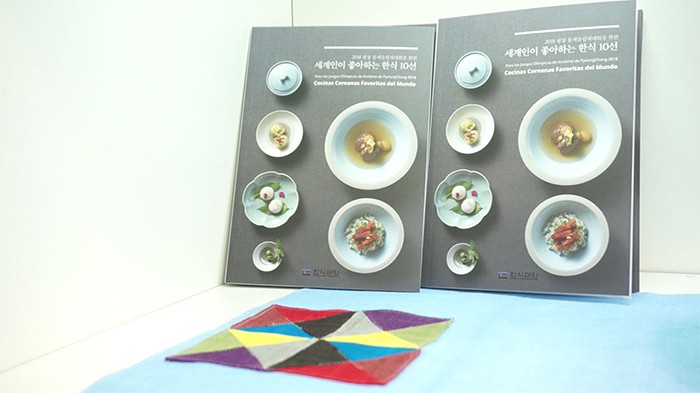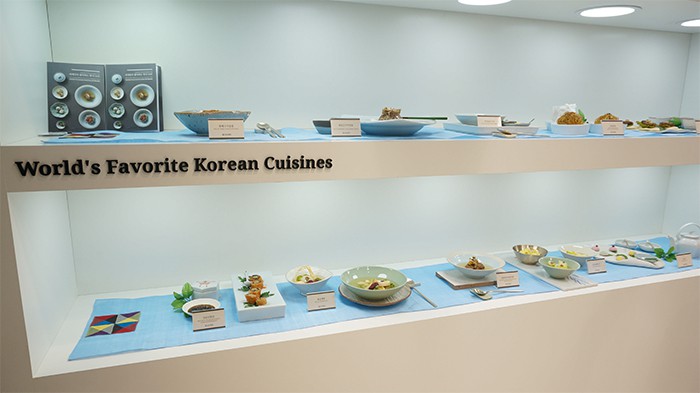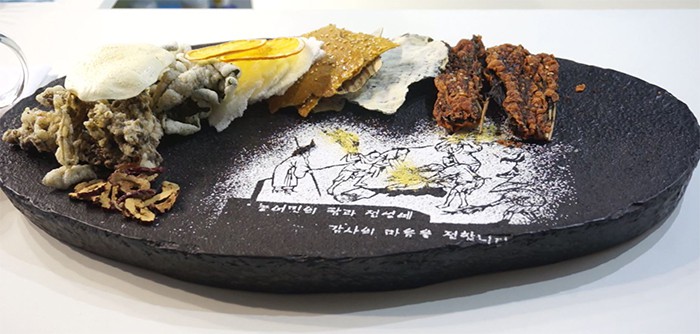
The 15th Madrid Fusion food festival, organized by the Municipal Palacio de Congress, was held from Jan. 23 to 25, one of the most prestigious international food events in the world. In Madrid this year, 167 exhibitors from the food service industry showcased their representative dishes — typical foods and many kinds of drinks, like beer and wine — and 117 speakers presented their new cooking techniques and talked about trends in the food industry to both officials and the public.

Visitors listen to an explanation about Korean cuisine, fermented condiments and fresh vegetables.

A book from the Korea Food Foundation explains some of the show’s favorite Korean dishes.
The Korean Food Foundation (KFF) and the Ministry of Agriculture, Food and Rural Affairs (MAFRA) participated in Madrid Fusion 2017, and this year they focused on fermented condiments. They presented some of the Korean food recipes that have been developed to suit the tastes of non-Koreans and which are being promoted ahead of the PyeongChang 2018 Olympic and Paralympic Winter Games next year. By utilizing the traditions and identity of traditional Korean cuisine, these newly-developed recipes reflect the latest trends, and capture not only the taste of Korean food but are also fun to enjoy.

On display are 10 newly-developed Korean dishes that are designed to be loved all around the world.
The 10 newly-designed Korean recipes, invented to appeal to non-Korean taste buds all around the world, are as follows. The three main dishes are: grilled dried pollack with rice, potato bibimbab mixed rice in a buckwheat wrap, and mushroom and corn porridge. The six side dishes are: simple japchae sweet potato vermicelli noodles with sautéed vegetables, modern bulgogi marinated and fried beef mini-patties, carrot shinwa savory pancakes, ginseng chicken roll soup, nutritious beef short rib patties with soup and triple white kimchi. Finally, the one dessert is a delicious marble rice cake.

One of the newly-designed recipes is simple japchae sweet potato vermicelli noodles with sautéed vegetables.

One of the yummier side dishes is modern bulgogi marinated and fried beef mini-patties.

Ginseng chicken roll soup was a hit in Madrid this year.
The above three dishes were the most popular at the fair. In fact, many non-Koreans have difficulty preparing japchae sweet potato vermicelli noodles, even though they all love it. However, simple japchae sweet potato vermicelli noodles with sautéed vegetables can be easily made at home with only vegetables. The modern bulgogi marinated and fried beef mini-patties, which are marinated and grilled so as to keep the juicy texture on the inside while maintaining a crispiness on the outside, were also really popular as a finger food. Also, ginseng chicken roll soup is one of Korea’s most popular soups for its energizing ingredients! Ginseng is rolled with chicken meat, as well as rice, and then simmered with Oriental herbs, thus reinterpreting a classical recipe with a modernist touch.

Chef Jung Jae Duk demonstrates how to make healthy vegetable and seaweed chips in the Multipurpose Hall on the last day of the Madrid food fair.

Healthy Korean snacks are best during the harvest.

The Korean food booth highlighted a different Korean dish each day of the food fair.
On the last day of the food fair, Chef Jung Jae Duk demonstrated how to make healthy vegetable and seaweed chips in the Multipurpose Hall. The healthy Korean snacks made from fresh local vegetables and colorful traditional fermented condiments — soy bean paste, soy sauce and red pepper paste — attracted a lot of attention with their unique textures and flavors.

Visitors enjoy the food on display in Madrid.

Visitors can taste wines from all around the world.

Delicious pig meat and different styles of seasoned or smoked pork are some of the most typical foods in Spain.
Visitors were able to taste many kinds of dishes from different countries and learn about the recipes, too, all while watching cooking demonstrations by famous chefs.
Finally, the curtain closed on Asia Madrid Fusion 2017 after receiving 12,300 attendees.

Visitors learn about Korean cuisine while sampling some drinks.

Chef Jung Jae Duk and Korean Food Foundation President Yoon Sook Ja pose for a photo with visitors.

Korean cuisine includes many fermented condiments.
Korean food is broadly based on fresh vegetables and fermented condiments. Many critics say that this could be the future of healthy food.
Finally, we hope that traditional Korean condiments will be listed as an intangible cultural heritage of humanity at UNESCO, and become famous food items enjoyed by more and more people all around the world.
By Kong JuHee
Korea.net Honorary Reporter
Photos: Kong JuHee
http://koreanetblog.blogspot.kr/2017/02/10-korean-dishes-loved-in-madrid.html























